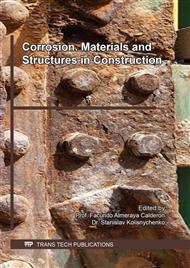p.620
p.626
p.632
p.638
p.647
p.653
p.659
p.665
p.672
Efficiency of Impressed Current Cathodic Protection in Repaired Reinforced Concrete
Abstract:
—Corrosion attack in reinforced concrete and thus contribute to degradation of concrete influenced by aggressive environment, represent a great concern in relation to the durability of reinforced concrete structures. In this respect, an interesting need is required that is patch repair with additional protection known as ICCP method to prolong the serviceability of the concrete structures. However, details inspection is crucial to understand the effect of different repairing materials and chloride content towards application of ICCP. To clarify this issue, non-protected and protected test specimens were prepared, and analyzed up to 175 days of protection. The result reveals that, reference specimen was found as most corroded specimen unable to obtain 100 mV depolarization at 56 days installation compared to repaired ones. However, all specimens show only greater depolarization values beyond 129 days of installation. To clarity further effectiveness of ICCP system to the studied specimens, time-dependence within 24 hours disconnecting CP current has been carried out and depolarization values was recorded every 4 hours interval. In the final analysis, all specimens are satisfying the CP criteria by obtaining depolarization potential ranging 100 to 250 mV at 4 and 24 hours monitoring period. Index Terms— corrosion attacks, reinforced concrete, repaired concrete, repairing materials, impressed current
Info:
Periodical:
Pages:
647-652
Citation:
Online since:
September 2020
Authors:
Price:
Сopyright:
© 2020 Trans Tech Publications Ltd. All Rights Reserved
Share:
Citation:



